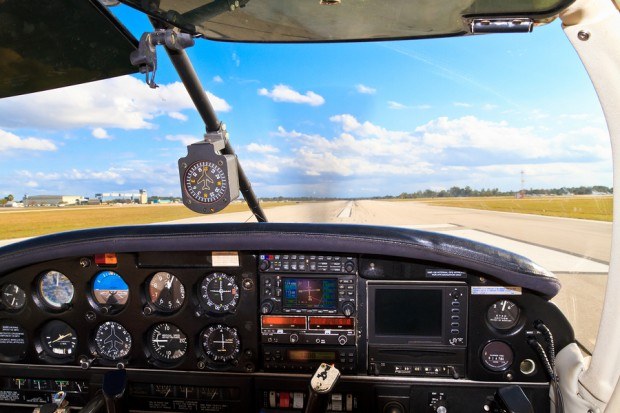Cockpit technology to cut the risk of on-ground airport collisions is moving toward commercial adoption as Honeywell International Inc. targets business jets like those favored by chief executive officers.
Three-dimensional, movable airport map displays for pilots eventually may lead to automated taxiing, said Bob Witwer, Honeywell’s aerospace vice president of advanced technology. The software may be available within a year, probably on jets from Gulfstream Aerospace Corp. or Dassault Aviation SA, he said.
“We’ve made huge strides in automating flight and almost no strides in the last 30 years changing the way pilots taxi, and what we’re doing here is looking to change that,” Witwer said yesterday during a visit to Honeywell’s technology laboratory near Phoenix.
The 3-D map system, which guides a pilot from the air to the gate with a magenta-colored line while flagging other planes and obstacles, is following a typical path for aerospace technology. It will first be used on business jets, where companies accept the extra costs to increase safety for top executives, then move to airliners after benefits are proven.
There’s an average of one runway incident a day around the world, with an annual cost of about $100 million for passenger injuries and aircraft repairs and inspections, according to Morris Township, New Jersey-based Honeywell.
Deadliest Accident
While those mishaps often involve just a crumpled plane or dented building, the deadliest accident in aviation history was a ground collision in 1977 in Tenerife, Canary Islands, between two Boeing Co. 747s that killed 583 people. In 2011, an Airbus A380 superjumbo jet flown by Air France clipped a Delta Air Lines Inc. commuter plane at New York’s Kennedy Airport.
Honeywell’s 3-D mapping is among the newest technologies under development at the maker of cockpit avionics and other aerospace equipment.
The company’s synthetic vision system, which combines computer graphics with radar images to give pilots a clearer view during inclement weather, will be in cockpits of Embraer SA’s upgraded E2 jets, marking the first use of the technology on an airliner. Those planes are due to enter service in 2018.
Synthetic vision comes standard on the G650, the top-of- the-line business jet from General Dynamics Corp.’s Gulfstream that debuted in late 2012.
Low Visibility
Honeywell is now working with the U.S. Federal Aviation Administration to certify synthetic vision for use at altitudes of less than 200 feet (61 meters) when runway visibility is low, which would allow pilots to make landings they otherwise couldn’t.
Voice-activated commands, eye-tracking technology and even sensors that can translate thoughts into actions — such as steering a plane to the left or right — are also under development at Honeywell, Witwer said.
“This is all about how to make the piloting experience safer, easier and more intuitive,” Witwer said.
Airplanes’ ground movements can be automated in the future by combining the airport maps technology with electric taxi, a product Honeywell is developing to power planes with an electric motor while on the ground instead of using the jet engines or a push-back tractor, Witwer said. Honeywell and partner Safran SA plan to introduce electric taxi in 2016.
“There’s a lot of technical hurdles to get over,” Witwer said. “It’s certainly within the realm of possibility.”
–Editors: Ed Dufner, John Lear





















 Slideshow: Carrier Management’s 2025 Top Editor’s Picks (Unlocked)
Slideshow: Carrier Management’s 2025 Top Editor’s Picks (Unlocked)  Northern California Flooding This Weekend Caused by Heavy Rain, High Tides
Northern California Flooding This Weekend Caused by Heavy Rain, High Tides  NOAA Announces Latest AI-Driven Global Weather Models
NOAA Announces Latest AI-Driven Global Weather Models  Underwriter, Actuary Fears of AI Drop; Work Needed on Collaboration
Underwriter, Actuary Fears of AI Drop; Work Needed on Collaboration 






